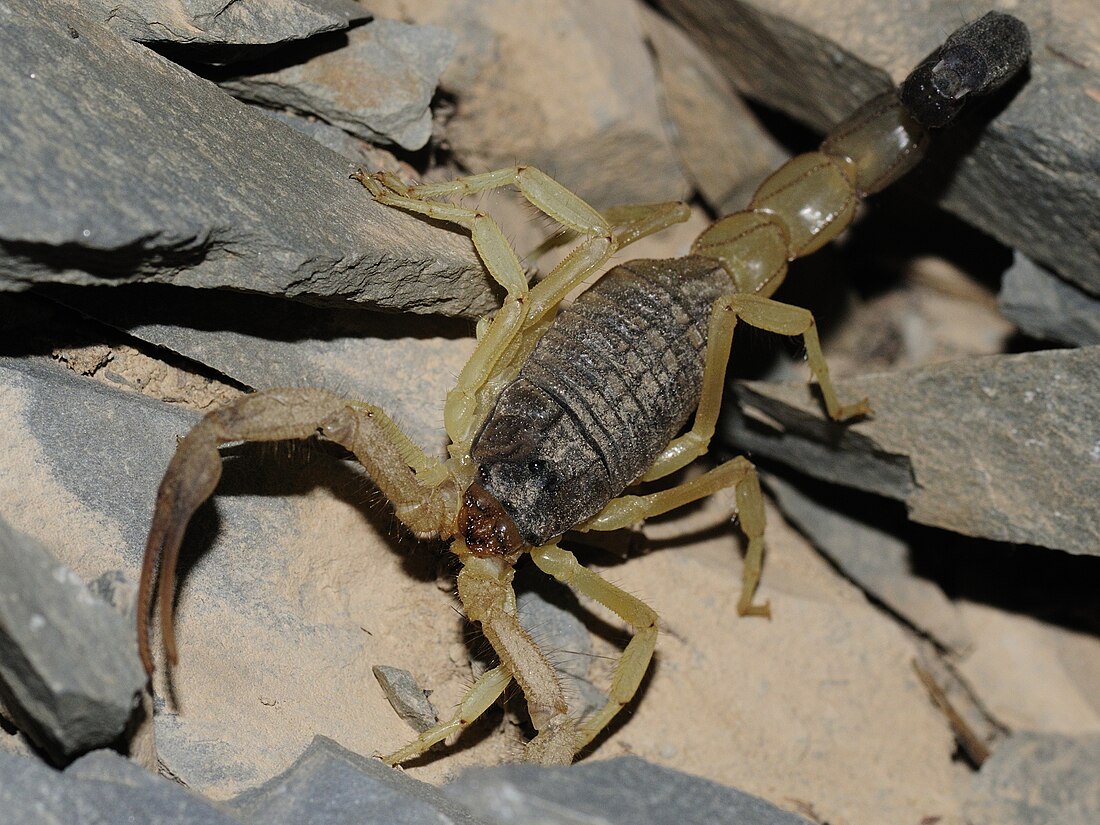Top Qs
Timeline
Chat
Perspective
Hottentotta
Genus of scorpions From Wikipedia, the free encyclopedia
Remove ads
Hottentotta is a genus of scorpions of the family Buthidae. It is distributed widely across Africa, except for most of the Sahara desert. Species in the genus also occur in the Middle East, the Arabian Peninsula, southeastern Turkey, Iraq, Iran, Afghanistan, Pakistan, India, Nepal, Cape Verde Islands, and Sri Lanka (introduced).
Remove ads
Remove ads
Taxonomy
Summarize
Perspective
The genus was introduced in 1908 by A. A. Birula, originally as a subgenus of the genus Buthus.[2] It was elevated to genus rank by F. Werner in 1934.[3] Buthotus Vachon, 1949 is an often used but outdated synonym of Hottentotta.[1]
Some authors subdivided the genus into three subgenera, Hottentotta (Hottentotta), Hottentotta (Balfourianus) Vachon, 1979,[4] and Hottentotta (Deccanobuthus) Lourenço, 2000.[5] The latest taxonomic reviews of this genus by F. Kovařík[1][6] reject this subdivision and recognizes a single, undivided genus Hottentotta. The differences separating the closely related genus Mesobuthus from Hottentotta are very subtle, and species have been often been misassigned among the two genera.[1][7]
Diversity
The content of this genus may vary, depending on the authority. At least 40-41 species are known:[1][6][7][8][9][10]
- Hottentotta alticola (Pocock, 1895)
- Hottentotta arenaceus (Purcell, 1902)
- Hottentotta buchariensis (Birula, 1897)
- Hottentotta caboverdensis Lourenço & Ythier, 2006
- Hottentotta conspersus (Thorell, 1876)
- Hottentotta finneganae Kovařík, 2007
- Hottentotta flavidulus Teruel & Rein, 2010
- Hottentotta franzwerneri (Birula, 1914)[11]
- Hottentotta fuscitruncus (Caporiacco, 1936)
- Hottentotta gentili (Pallary, 1924)[11]
- Hottentotta hottentotta (Fabricius, 1787) (type species)
- Hottentotta jabalpurensis Kovařík, 2007
- Hottentotta jalalabadensis Kovařík, 2007
- Hottentotta jayakari (Pocock, 1895)
- Hottentotta judaicus (Simon, 1872)
- Hottentotta khoozestanus Navidpour, Kovařík, Soleglad & Fet, 2008
- Hottentotta lacroixi Ythier & Dupre, 2021
- Hottentotta lorestanus Navidpour, Nayebzadeh, Soleglad, Fet, Kovařík & Kayedi, 2010
- Hottentotta mateui Lourenço, Duhem & Cloudsley-Thompson, 2012
- Hottentotta mazuchi Kovařík, 2013
- Hottentotta minax (L. Koch, 1875)
- Hottentotta minusalta Vachon, 1959
- Hottentotta mesopotamicus Lourenço & Qi, 2007
- Hottentotta niloticus (Birula, 1928)
- Hottentotta pachyurus (Pocock, 1897)
- Hottentotta pellucidus Lowe, 2010
- Hottentotta penjabensis (Birula, 1897)
- Hottentotta polystictus (Pocock, 1896)
- Hottentotta rugiscutis (Pocock, 1897)
- Hottentotta saulcyi (Simon, 1880)
- Hottentotta saxinatans Lowe, 2010
- Hottentotta scaber (Ehrenberg, 1828)
- Hottentotta schach (Birula, 1905)
- Hottentotta socotrensis (Pocock, 1898)
- Hottentotta songi (Lourenço, Qi & Zhu, 2005)
- Hottentotta sousai Turiel, 2014
- Hottentotta stockwelli Kovařík, 2007
- Hottentotta tamulus (Fabricius, 1798)
- Hottentotta trailini Kovařík, 2013
- Hottentotta trilineatus (Peters, 1861)
- Hottentotta ugandaensis Kovařík, 2013
- Hottentotta zagrosensis Kovařík, 1997
Disputed species
- Hottentotta syrticus (Borelli, 1914) and Buthotus (=Hottentotta) asimii Amir, Kamaluddin & Khan, 2004 are considered nomina dubia.[1][12]
Remove ads
General characteristics
Summarize
Perspective
Members of Hottentotta are generally moderately sized scorpions, with a total length of 70–90 millimetres (2.8–3.5 in); the smallest species are 30 millimetres (1.2 in) long, while the largest species reach 100–130 millimetres (3.9–5.1 in). They belong to the most colorful species of scorpions. The base color ranges from bright yellow to black, with most species colored in brown or reddish tones. Many species are ornamented by color spots or bands especially on the mesosoma. Coloration may be considerable variable between individuals of the same species or among regional populations.[1]
They show a typical buthid habitus with gracile pedipalp chelae and a moderately thickened metasoma. The vesicle is bulbous and proportionally large in some species. The cephalothorax and mesosoma shows distinct granulation in most species, some are strongly hirsute. The tergites of the mesosoma bear three distinct, longitudinal carinae (ridges).[1]
Toxicity
As in other buthids the venom in at least some species of Hottentotta is relatively potent and can be of medical importance to humans.
Hottentotta tamulus, the Indian red scorpion, has evidently caused human fatalities by cardiovascular and pulmonary manifestations of intoxication[13][14][15] and is considered the most lethal scorpion species in the world.[16]
Kleber et al. (1999)[17] listed envenomation by at least four other species as to cause clinically significant symptoms.
This listing is not comprehensive due to lack of data and all species of Hottentotta are potentially highly venomous to humans. Note that the LD50 value might differ considerably between populations of the same species.
Remove ads
Habitat
Most species live in semi-arid to humid, steppe, savannah and forested environments. Hyperarid deserts are avoided. Some reach considerable topographic altitudes as e.g. in the Atlas Mountains, the Zagros Mountains or at the Hindukush.
In captivity
Due to their relatively colorful appearance Hottentotta species are often kept and bred in captivity. Popular species are H. hottentotta and H. trilineatus. As with other highly venomous buthids keeping these species in captivity is only recommendable to experienced people.
References
External links
Wikiwand - on
Seamless Wikipedia browsing. On steroids.
Remove ads

